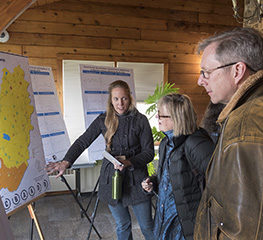
2018 State of Our Watershed Conference and “Data Reveal”
How healthy are the streams in your town? If you live throughout much of the upper Raritan River watershed, most are doing well but many need improvement.
That was the take-away from Raritan Headwaters Association’s annual State of Our Watershed conference on Saturday, Dec. 1, in Califon.
Based on data from the watershed watchdog’s stream monitoring program in Hunterdon, Somerset and Morris counties, local waterways got a “C” grade on the 2018 water quality report card.
According to Dr. Kristi MacDonald, science director for Raritan Headwaters, “One in four stream sites are biologically impaired due to pollution and poor habitat conditions.”
Sixteen percent of local streams scored “excellent” in water quality indicators, 56 percent scored “good,” 25 percent scored “fair,” and 3 percent scored “poor.” Streams with excellent or good ratings are acceptable for aquatic life, according to the federal Clean Water Act. Streams with “fair” or “poor” ratings are considered impaired and not acceptable habitat.
“Overall, our water quality is good,” said MacDonald. “But because we’re the headwaters of the Raritan River and the source of drinking water for 1.5 million people in New Jersey, our goal is to receive an ‘A’ in all areas. Stream health can be improved through better stormwater management, green infrastructure, stream bank restorations, river-friendly best management practices and the protection of forests and wetlands.”
Stormwater runoff from buildings, pavement, and even lawns is a particular concern. When rain falls onto surfaces impervious to water, it carries contaminants into storm drains and then into streams, including road salt and motor oil from roadways, and fertilizers, pesticides and animal waste from farms and homes. In addition, the water does not have a chance to recharge our aquifers, which supply drinking water to most residents of the watershed.
Testing the Waters
Cindy Ehrenclou, executive director of Raritan Headwaters, said compiling the annual stream quality report card is one way the nonprofit works to educate local residents about issues affecting their water quality. “We’re the region’s watershed watchdog, and our mission is to make sure all local waterways are swimmable, fishable and, above all, drinkable,” she said.
The upper Raritan River watershed includes the North and South Branches of the Raritan, and numerous tributary rivers and streams. The watershed covers 470 square miles within Hunterdon, Somerset and Morris counties, from Budd Lake and Roxbury Township in the north to East Amwell in the south. The watershed includes two of the state’s largest water supply reservoirs, Round Valley and Spruce Run.
Every year in June, RHA staff members and volunteer citizen scientists conduct biological monitoring at 64 stream sites in the watershed. Using nets, they sample the streams for bottom-dwelling creatures known as benthic macroinvertebrates. Certain macroinvertebrates are very sensitive to pollution, making their presence an indicator of good stream health.
Raritan Headwaters data highlights harmful impacts of stormwater runoff, fertilizers, bacteria and road salt.
In addition to biological monitoring, Raritan Headwaters also conducts chemical, bacterial and habitat monitoring. Nitrates, phosphates, temperature, dissolved oxygen, pH, turbidity, specific conductance and bacteria levels are measured once a year at all stream monitoring sites and quarterly at impaired sites. Due to concerns over salt pollution of surface water and groundwater, chloride was recently added to the parameters tested.
How are the streams in your town?
Stream sites ranked excellent include long stretches of the South Branch in Washington Township, Clinton Township, Raritan Township and Readington Township; and also the Capoolong Creek in Franklin Township (Hunterdon County), Rockaway Creek in Tewksbury Township, Black River in Chester Township and Herzog Brook in Bedminster Township.
Stream sites ranked good include most of the North Branch from Mendham to the confluence of the South Branch in Branchburg. Also rated good were several locations along the South Branch and its tributaries that were not rated excellent.
Streams ranked fair include a concentration of sites ranked at the southern end of the watershed, within the Neshanic River sub-watershed in Hunterdon County. This area is heavily agricultural, and rains carry fertilizers, pesticides and animal wastes into streams.
Other sites ranked fair include sections of the North Branch near Natirar Park in Peapack-Gladstone, the Spruce Run in Union Township, the Beaver Brook in Clinton Township, the Rockaway Creek in Readington Township, the Cold Brook in Tewksbury Township, and the Middle Brook in Bedminster.
Only two sites within the watershed ranked poor: the Black River in Randolph Township, where it is dammed to become Lake Lillian; and the Drakes Brook in Mount Olive Township, located downstream from an old landfill.
To see in-depth information about all 64 stream sites, go to www.raritanheadwaters.org/watershed-report/.
According to Raritan Headwaters, here’s what residents can do to improve stream quality:
- Pick up and dispose of dog waste
- Inspect and maintain home septic systems
- Properly store farm animal manure
- Don’t feed wild geese that congregate around ponds and riverbanks
- Maintain vegetated buffers around streams and ponds
- Install green infrastructure like rain gardens to filter runoff water
- Use fewer chemicals fertilizers and pesticides
- Urge local officials not to oversalt roads during the winter
About Raritan Headwaters
Raritan Headwaters has been working since 1959 to protect, preserve and improve water quality and other natural resources of the Raritan River headwaters region through efforts in science, education, advocacy, land preservation and stewardship. RHA’s 470-square-mile region provides clean drinking water to 300,000 residents of 38 municipalities in Somerset, Hunterdon and Morris counties and beyond to some 1.5 million homes and businesses in New Jersey’s densely populated urban areas.
Raritan Headwaters recently was accredited by the national Land Trust Accreditation Commission, meaning it has been recognized as a strong and effective organization committed to professional excellence and maintaining the public’s trust.
To learn more about Raritan Headwaters and its programs, please visit www.raritanheadwaters.org or call 908-234-1852.



